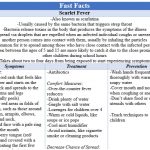What does it have to do with your throat?
Your son wakes up complaining of a sore throat and you notice that he has a bright red rash on his face and neck. His temperature is high, so you take him to the doctor. You find out that he has scarlet fever. What caused it to appear? How do you treat it? Is it contagious?
 Definition
Definition
Scarlet fever, or scarlatina, is usually caused by the same bacteria that triggers strep throat. In this case, the bacteria release toxins in the body that produces the symptoms of the illness. Just as with strep throat, the infection is spread via droplets that are expelled when an infected individual coughs or sneezes and another person comes into contact with them, usually by inhaling the particles. This is why it’s common for it to spread among those who have close contact with the infected person. Also, children between the ages of 5 and 15 are more likely to catch it due to the close proximity to other children during school hours. It takes about two to four days from being exposed to start experiencing symptoms.
There are several symptoms that are distinct. The first is the red rash that appears on the body. The rash is usually bright red, similar to sunburn, and feels like sandpaper. It starts on the face/neck and spreads to the torso, arms and legs. If you press on the rash, it’ll turn pale. The folds of the skin, such as those around the groin, armpits, elbows, knees and neck, typically become a deeper red color than the other parts of the body. The rash can make the person’s face appear flushed, but there’s often a pale ring around the mouth. Another classic symptom of scarlet fever is strawberry tongue. This means the person’s tongue looks red and bumpy. Sometimes, it’s covered with a white coating the first few days of the infection. All of these last about a week and the skin that was impacted by the rash usually peels. Other possible symptoms are a fever of 101°F or higher, chills, very sore/red throat (sometimes has white/yellowish patches), difficulty swallowing, enlarged lymph nodes in the neck that are painful when touched, nausea/vomiting and headache. If you’re child has a temperature of 102°F or higher, swollen/sore glands in the neck or a bright red rash, you should call their doctor. If not treated, the bacteria that causes scarlet fever can proliferate to the tonsils, middle ear, lungs, kidneys, blood and skin. In some cases, it can lead to rheumatic fever, which is a serious condition that can impact the heart, joints and nervous system.
Treatment
If you’re child’s doctor suspects that they have scarlet fever, they’ll want to swab the back of their throat to see if they have a strep throat infection as well. Since there are many illnesses that have similar symptoms to scarlet fever, it’s essential that the doctor finds the exact cause in order to prescribe the right treatment. If your child does have scarlet fever, they’ll need to take antibiotics to help clear it up. When giving the antibiotic to your child, you need to make sure that they take all of it as prescribed, even if they’re feeling better before it’s gone. If they don’t the infection may not be completely eliminated from their body and this increases their chances of developing complications. Once your child is on antibiotics for at least 24 hours and they no longer have a fever, they can usually return to school.
Many of the symptoms of scarlet fever are uncomfortable. There are things that you can do to help alleviate them for your child. Manage the fever by giving over-the-counter medications, such as ibuprofen or acetaminophen. To ensure your child stays hydrated, be sure they drink plenty of water. This will also help to keep their throat moist, which should make it less sore. If your child is old enough to gargle, you can give them salt water to do this. This should also help to reduce the pain in their throat. Another option is to give them lozenges, but this should only be for children over the age of 4 in order to prevent choking. Providing warm or cold liquids, like soups or ice pops, can help to deliver some relief too. Using a cool mist humidifier and avoiding irritants, like cigarette smoke or cleaning products, is helpful in decreasing throat irritation. Since the disease is contagious, it’s important to do everything you can to reduce the chances of it spreading by washing drinking glasses, eating utensils and toys in hot, soapy water.
Prevention
There isn’t a vaccine for scarlet fever, so the best way to prevent it is through strategies that you would use to protect yourself against all germs. The most important of these is to wash your hands frequently and thoroughly with warm soapy water. You should also cover your mouth and nose when you cough or sneeze. Not sharing food or eating utensils with others is key since this is an easy way for germs to be passed from one person to another. Not only is it vital to practice these techniques yourself, but it’s critical to teach them to your children since they’re the ones more likely to contract the illness.
Scarlet fever can be an unpleasant situation for anyone to deal with, let only children. By following the doctor’s instructions regarding antibiotics and offering comfort measures, your child will be back to their normal self in no time. If you have any questions or concerns about scarlet fever, please speak with your child’s doctor. If you would like more information, please visit the Center for Disease Control and Prevention’s (CDC) Scarlet Fever page at https://www.cdc.gov/groupastrep/diseases-public/scarlet-fever.html